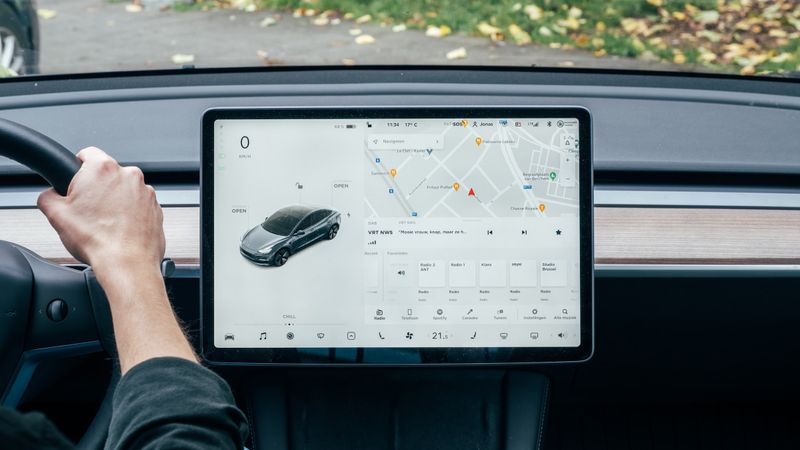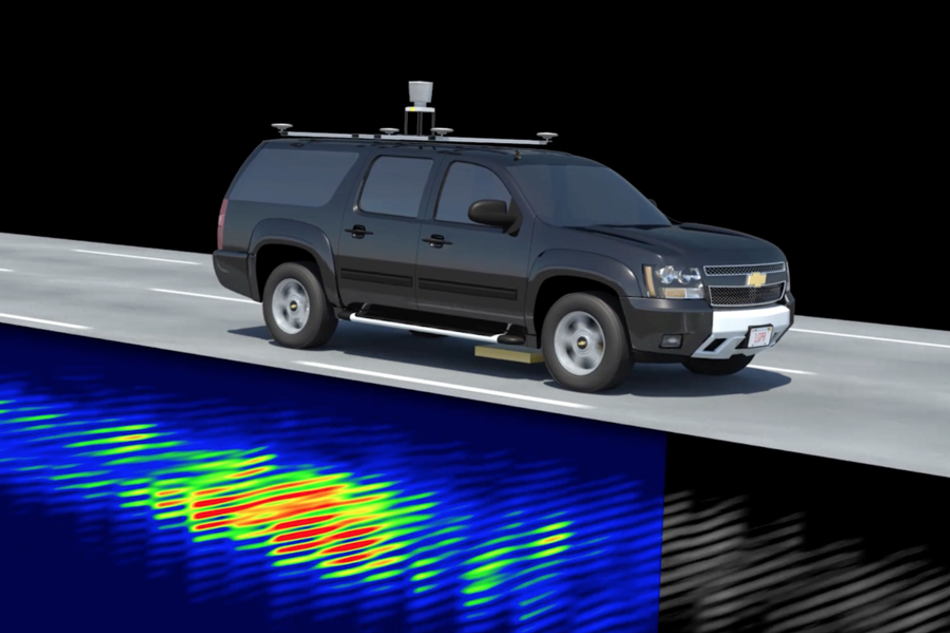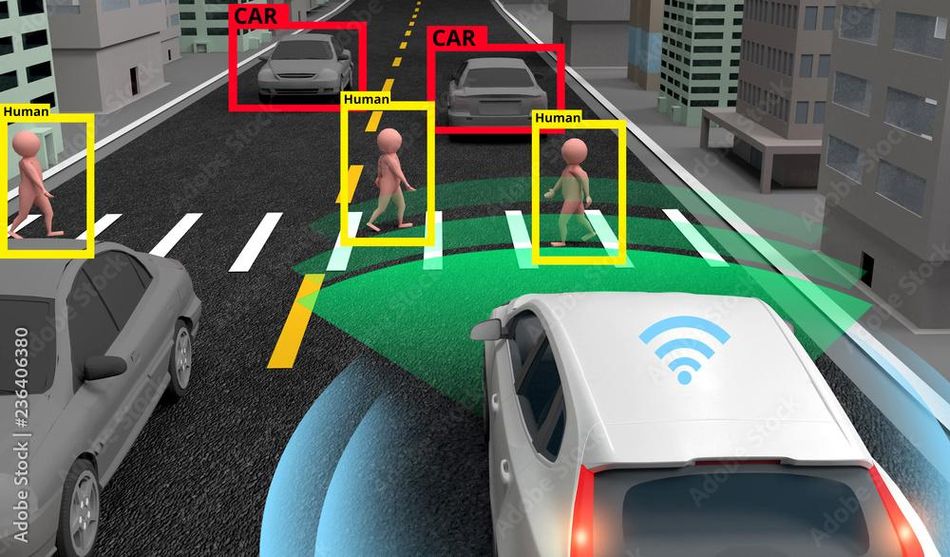Autonomous and Electric Vehicles: The Future of Mobility
Article #1 of Innovations in Electric and Autonomous Vehicles Series: With so much emphasis on electrification, advancements in autonomous driving seem to have taken a backseat. Let’s take a look at the changes required to reach the point where cars drive around without needing any manual intervention.

Dashboard of a Tesla Model 3, a fully electric vehicle with autopilot features
This is the first article in an 8-part series featuring articles on Innovations in Electric and Autonomous Vehicles. The series presents an insight into the developments and challenges in the automotive sector as it undergoes massive transformations with the arrival of electric and self-driving vehicles. This series is sponsored by Mouser Electronics. Through the sponsorship, Mouser Electronics shares its passion for technologies that enable smarter and connected applications.
Electrification of the automotive industry is in full swing. The first real step-change in powertrain development since original equipment manufacturers (OEMs) rolled out the internal combustion engines early in the 20th century has unlocked opportunities for true innovation, including electric vehicle (EV) range expansion, increased horsepower, and enhanced battery supercharging.
In addition, investments are pacing with development needs to enable product development: Ford announced a $22 billion expenditure by the middle of the decade to reach carbon neutrality by 2050.[1] General Motors (GM) is releasing thirty new EVs by 2025 to target selling only zero-emission vehicles by 2035.[2] GM has also announced a partnership with Honda to develop affordable EVs for a 2027 launch, augmenting the luxury and high four-figure price points of many available and near-launch vehicles.[3]
With so much emphasis—and funding—on electric vehicles, where do autonomous cars fit in?
In 2015, Tesla's Elon Musk predicted that fully autonomous vehicles were only two years away.[4] However, Mercedes-Benz has won the global race to become the first company to achieve Society of Automotive Engineers (SAE) Level 3™ autonomy for highway driving. Next in line are GM and Tesla, who have reached SAE Level 2™ (driving automation) with advanced driver assist (ADAS). And while SAE Level 3™ transitions from the human monitoring the driving environment to the automated system, it won't be until SAE Level 4™ that the car truly drives for us.
After billions of dollars invested in technology R&D, we are barely halfway to the lofty goal of fully self-driving cars five years after Musk's prediction—and counting. This article will provide the current status of autonomous driving technology and postulate when—or if—we'll ever reach SAE Level 5™.
Market Drivers for Autonomous Vehicles
The market drivers for autonomous vehicles (AVs) are still in place. However, EVs lend themselves to independent operation by delivering a more stable power source to operate advanced sensing and processing intensity at low latency. Despite these, several headwinds have stalled autonomous driving technology development as EVs permeate the market: the lack of EVs on the road, component shortages, competition for technical resources with standard EV development, and the sheer technical challenge of a car that drives itself.
In the face of these challenges, four market drivers still enable vehicular autonomy.
Safety
According to the National Highway Traffic Safety Administration (NHTSA), a United States government agency, human error caused over 90% of motor vehicle crashes in 2019.[5] As a result, city and highway officials and the medical community support AV development to remove or reduce human driving errors. When you factor in the changing weather patterns and various road conditions, it is apparent why removing a significant source of crashes is advantageous.
Environmental Advantages
Autonomous vehicles' connection with the Internet of Things (IoT) enables the system to optimize battery efficiency while extending range. Greater processing control delivers more output with the same input source energy. Regulatory pressure also plays a role, creating an increasingly narrow landscape for vehicle emissions.
Smart City Connection
As Industry 4.0 connects more previously disconnected entities, the rise of the smart city increases the benefit of AV. Having the vehicle and the city infrastructure communicate creates an attractive opportunity for city planners to mitigate traffic jams, divert traffic instantly after a crash or during road construction, and ensure the vehicles sync to the city lights at dusk to ensure proper road lighting.
Driver/Passenger Convenience
Increasingly, drivers' distraction has increased. "Don't text and drive" radiates from illuminated billboards and traffic signs to implore drivers to be safe when driving. The desire for vehicle occupants to stay connected will only increase, however. If the vehicle could handle the driving function, users would now be free to work, network, or browse during a car ride.
Stepping Up to SAE Level 3 Automation and Beyond
Advancements in Artificial Intelligence (AI) provide the most significant progress toward full autonomy, set by the SAE as SAE Level 5™ on a 0–5 scale. Mercedes-Benz won the race to SAE Level 3™ autonomy with its Drive Pilot system, securing an on-highway license in early 2022.[6] It integrates light detection and ranging (LiDAR), a rear window camera, and microphones to communicate with external influencers like traffic signs and crash alerts, road topography, and satellite-dictated route descriptions.
Tesla still prioritizes vehicle autonomy, developing "Autopilot" software that can change lanes and navigate turns. The driver assistance platform enables the car to take its passengers around with minimal intervention, though it is not independent of human monitoring and override when needed.
GM offers "Ultra Cruise," a hands-free platform that handles turns and city streets in addition to highways, amounting to approximately 95% of traffic scenarios involving paved roads.[7]
Following these leading systems, Ford, Volvo, and BMW have shown promise among traditional OEMs, with Apple, Waymo, and Nvidia leading the effort from technology-driven companies. While achieving SAE Level 3™ is a significant milestone, SAE Level 4™ is where transformative vehicle autonomy will occur.
Reaching Higher Levels of Autonomy with Improved Environmental Sensing
The success of many companies reaching SAE Level 2™ and most offering SAE Level 1™ autonomy has uncovered several "building blocks" of autonomous technology. These blocks are the eyes and ears of AVs.
LiDAR and RADAR
LiDAR acts as a remote sensor to detect the exact distance of objects outside the vehicle. Radio detection and ranging (RADAR) uses radio waves for a similar purpose, along with the angle and speed of nearby items. Given the typical challenges described below, a combination of LiDAR and RADAR has proven effective in many leading OEMs' autonomous demonstrations.
Cameras and Ultrasonic Sensors
LiDAR and RADAR detect the conditions outside the vehicle and feed that data to the central processor. Cameras collect additional input via video and add this to the system's analysis. They require complex video processing algorithms to interpret the collected images. A fourth technology, ultrasonic sensors, round out the traditional tools to inform autonomous driving. These sensors provide short-distance information and are often leveraged to aid parking and backup systems.
The shortcomings of the combination of light/radio ranging and video and sensors present the first substantial hurdle OEMs need to clear to progress to the upper levels of autonomous driving. In addition, this approach is strongly affected by environmental and weather conditions and the clarity of image data the system receives. Overcoming these issues requires genuinely disruptive innovation.
Hot Development Areas
Mercedes-Benz still achieved SAE Level 3™ by combining the above technologies with microphones. But as mentioned, reaching SAE Level 4™ will be the light-off point for mainstream autonomous driving. The next step to address the limitations of the traditional approach may be found within new methods to how the vehicle receives information.
Localizing Ground-Penetrating RADAR (LGPR)
RADAR is especially susceptible to vehicular vibration, a common occurrence on roads exposed to extreme temperatures and various weather types throughout the year. Researchers at MIT developed an improvement to this technology, initially aimed at military applications called LGPR.
The enhanced radar creates a digital map of the road surface by sending radio waves into the ground. This map provides a reference state for vehicle sensors because the ground topography is not weather- or condition-dependent. In addition, the reference state eliminates unreliable RADAR data due to vibration.
Thermal Imaging
Thermal imaging sensors are a type of all-weather camera that detects differences in heat at longer wavelengths than those in the visual spectrum. No longer limited by what humans can see, these sensors excel at discerning humans from objects in any weather and different animals and external factors.
Artificial Intelligence
As mentioned, advancements in AI are enabling vehicle autonomy with every improvement. As AI consumes more data, the algorithms can continuously employ machine learning to improve driving performance. In addition, the technology provides instant, adaptive modeling to create more accurate environmental scenarios. Like predictive maintenance in manufacturing, AI can predict car performance changes due to normal wear and tear and changing road conditions over time.
Barriers and Current Challenges
The current systems' challenges largely depend on the weather, image variability, or technology failure. In addition, human and commercial factors present practical hurdles to augmenting the technical ones.
Weather
There are several stories in which sun glare hampered a vehicle's ability to accurately assess its surroundings. These issues, coupled with heavy rain, snow, or fog conditions, limit the accuracy of LiDAR and cameras. Autonomous driving depends on accurate information about ambient conditions, and random weather events render the signal sent by imaging technology a metaphorical shot in the dark.
Image Variability
Similar to weather-related limitations, variable images due to poor focus or inaccurate depth perception hinder the vehicle's ability to receive and process information accurately. In addition, there is a near-infinite amount of combinations of object depth and focal points, and current technology needs to be more robust to process all situations accurately and rapidly.
Vibration and Sensor Failure
As noted above, vibration impairs RADAR information, creating unreliable source data that inhibits autonomous performance. Vibration is a critical durability test analyzed with computer-aided engineering during product design and validated as part of product development. Exposing the complex equipment to (actual or simulated) buckled road conditions also risks damaging the sensor equipment. The vehicle's performance is only as good as the data it receives, and sensor failure due to rough terrain is a legitimate potential failure mode with severe consequences.
Human Behavior and Rate of Adoption
Autonomous driving is a disruptive force to how we live our lives at the moment. If we no longer need to operate the car, we instantly free up hours per week. We can conduct personal or professional business during this time, get ready for work, video call a distant family member, help children with homework, or perform other activities.
Before reaching this state, it is worth considering what would happen if only some vehicles on the road were autonomous. Many people like to drive, and some may not want a computer guarding their safety, despite the many advancements.
Can we really achieve an autonomous driving society if the human element still exists?
Cost Considerations and Competition for EV Resources
The ultimate practical barrier is cost. The additional equipment that comprises an autonomous driving package option will not be free. Even with incentives or other commercial levers to encourage adoption, the outcome is likely an upcharge to the consumer, at least at first. This constraint may discourage some potential market entrants. Another related challenge is insurance; on the one hand, the industry predicts autonomous features to reduce crashes drastically, but the contents of the car increase, requiring more insurance to cover the self-driving features.
Finally, the sprint to ramp up EVs may take attention, resources, and momentum away from autonomous development. EVs are the preferred architecture for independent features due to power reliability, but OEMs may elect to reduce the intensity of AV development to accelerate EV (alone) at first.
Towards Higher Levels of Autonomy
The benefits of autonomous vehicles are still worth the development and resource investment to deliver them: substantially improved safety, sustainability improvements, integration with the smart city, and occupant comfort. However, to step all the way to SAE Level 5™, some technology areas need step-change innovation. Among these are sensors, integrating technology, AI, and combining thermal imaging and localizing ground-penetrating RADAR with existing approaches.
It will be interesting to see whether traditional OEMs can add the necessary technology to achieve SAE Level 4™ or whether vehicle engineering has matured to a plateau and the technology-led companies will develop the breakthrough solution.
Conclusion
The technological innovation needed to deliver this transformative, life-changing method of transportation will compel industry participants to continue sprinting to the finish line. It will likely take an optimal combination of existing and new technologies to tie the vehicle's perspective to its external surroundings in all conditions.
This article is based on an e-book by Mouser Electronics. It has been substantially edited by the Wevolver team and Electrical Engineer Ravi Y Rao (GOOD) (GOOD). It's the first article from the Innovations in Electric and Autonomous Vehicles Series. Future articles will introduce readers to some more trends and technologies transforming the automotive sector.
The introductory article (GOOD) (GOOD) presented the different topics covered in the Innovations in Electric and Autonomous Vehicles Series.
The first article (REDIRECT) (REDIRECT) discussed the present state of autonomous vehicles.
The second article (REDIRECT) (REDIRECT) explains MaaS and how improvements in automotive technologies are speeding up its adoption.
The third article (REDIRECT) (REDIRECT) takes a look at how the 3GPP intends to use 5G in V2X applications with significant advantages over current dedicated short-range communication or other Cellular-V2X proposals.
The fourth article (REDIRECT) (REDIRECT) explains Driver Monitoring Systems (DMS) and their role in reducing the possibility of mishaps due to human errors
The fifth article (REDIRECT) (REDIRECT) examines some of the ways EV technologies will evolve, and some of the obstacles they need to overcome before the automotive industry can transition to fully electric
The sixth article (REDIRECT) (REDIRECT) discusses solid-state batteries, a promising alternative to conventional Li-ion batteries
The seventh article (REDIRECT) (REDIRECT) explains active noise cancellation and why it’s a very effective solution for eliminating noises in automobiles
The final article (REDIRECT) (REDIRECT) focuses on Human Machine Interfaces, the sleek and stylish dashboards that are changing the way we interact with cars
About the sponsor: Mouser Electronics
Mouser Electronics is a worldwide leading authorized distributor of semiconductors and electronic components for over 1,200 manufacturer brands. They specialize in the rapid introduction of new products and technologies for design engineers and buyers. Their extensive product offering includes semiconductors, interconnects, passives, and electromechanical components.
References
[1] Sam Abuelsamid, ‘Ford Doubling Investment In Electric Cars And Trucks To $22 Billion’, 4th Feb. 2021, Forbes, [Online], Available from: https://www.forbes.com/sites/samabuelsamid/2021/02/04/ford-doubles-investment-in-electrification-to-22b-7b-for-avs/?sh=3ddcac6a2d25 (EXTERNAL) (EXTERNAL)
[2] Sam Mceachern, ‘General Motors To Launch 30 New EVs Worldwide By 2025’, GM Authority, 19th Nov 2020, [Online], Available from: https://gmauthority.com/blog/2020/11/general-motors-to-launch-30-new-evs-worldwide-by-2025/ (EXTERNAL) (EXTERNAL)
[3] Newsroom: GM and Honda Will Codevelop Affordable EVs Targeting the World’s Most Popular Vehicle Segments, GM, [Online], Available from: https://news.gm.com/newsroom.detail.html/Pages/news/us/en/2022/apr/0405-gmhonda.html (EXTERNAL) (EXTERNAL)
[4] Kirsten Korosec, ‘Elon Musk Says Tesla Vehicles Will Drive Themselves in Two Years’, Fortune, 22nd Dec. 2015, [Online], Available from: https://fortune.com/2015/12/21/elon-musk-interview/ (EXTERNAL) (EXTERNAL)
[5] Adam Kimmel, Is Autonomous Operation Still a Target for Electric Vehicles?, Mouser Electronics, 27th Aug. 2021, [Online], Available from: https://www.mouser.com/blog/is-autonomous-operation-still-a-target-for-evs (EXTERNAL) (EXTERNAL)
[6] Adam Gavine, Mercedes-Benz receives world’s first approval for Level 3 autonomy, Vehicle Dynamics International, 6th Jan. 2022, [Online], Available from: https://www.vehicledynamicsinternational.com/news/oem-news/mercedes-benz-receives-worlds-first-approval-for-level-3-autonomy.html (EXTERNAL) (EXTERNAL)
[7] Newsroom: GM Announces Ultra Cruise, Enabling True Hands-Free Driving Across 95 Percent of Driving Scenarios, GM, [Online], Available from: https://news.gm.com/newsroom.detail.html/Pages/news/us/en/2021/oct/1006-ultracruise.html# (EXTERNAL) (EXTERNAL).



